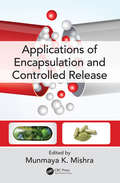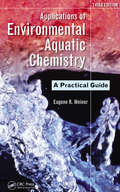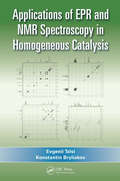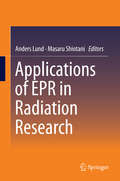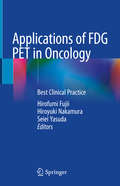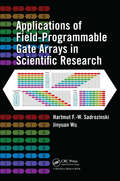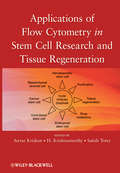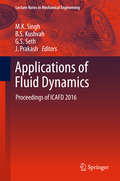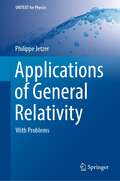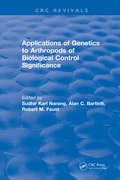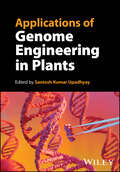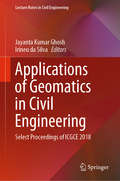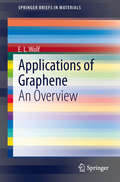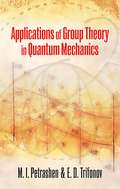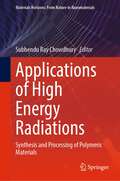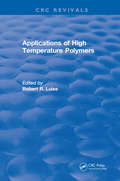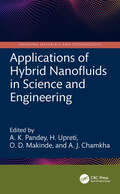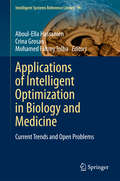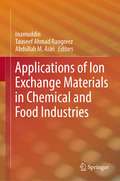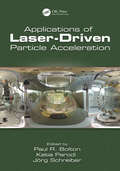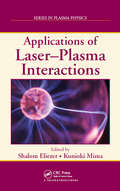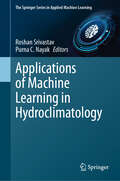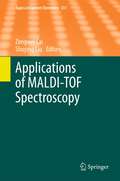- Table View
- List View
Applications of Encapsulation and Controlled Release (Encapsulation and Controlled Release)
by Munmaya K. MishraThe field of encapsulation, especially microencapsulation, is a rapidly growing area of research and product development. Applications of Encapsulation and Controlled Release offers a broad perspective on a variety of applications and processes, including, up-to-date research, figures, tables, illustrations, and references. Written at a level comprehensible to non-experts, it is a rich source of technical information and current practices in research and industry.
Applications of Environmental Aquatic Chemistry: A Practical Guide, Third Edition
by Eugene R. WeinerProfessionals and students who come from disciplines other than chemistry need a concise yet reliable guide that explains key concepts in environmental chemistry, from the fundamental science to the necessary calculations for applying them. Updated and reorganized, Applications of Environmental Aquatic Chemistry: A Practical Guide, Third Edition pr
Applications of EPR and NMR Spectroscopy in Homogeneous Catalysis
by Evgenii Talsi Konstantin BryliakovThis book reviews advances in important and practically relevant homogeneous catalytic transformations, such as single-site olefin polymerizations and chemo- and stereo-selective oxidations. Close attention is paid to the experimental investigation of the active sites of catalytic oxidation systems and their mechanisms. Major subjects include the applications of NMR and EPR spectroscopic techniques and data obtained by other physical methods. The book addresses a broad readership and focus on widespread techniques available in labs with NMR and EPR spectrometers.
Applications of EPR in Radiation Research
by Anders Lund Masaru ShiotaniApplications of EPR in Radiation Research is a multi-author contributed volume presented in eight themes: I. Elementary radiation processes (in situ and low temperature radiolysis, quantum solids); II: Solid state radiation chemistry (crystalline, amorphous and heterogeneous systems); III: Biochemistry, biophysics and biology applications (radicals in biomaterials, spin trapping, free-radical-induced DNA damage); IV: Materials science (polymeric and electronic materials, materials for treatment of nuclear waste, irradiated food); V: Radiation metrology (EPR-dosimetry, retrospective and medical applications); VI: Geological dating; VII: Advanced techniques (PELDOR, ESE and ENDOR spectroscopy, matrix isolation); VIII: Theoretical tools (density-functional calculations, spectrum simulations).
Applications of FDG PET in Oncology: Best Clinical Practice
by Hirofumi Fujii Hiroyuki Nakamura Seiei YasudaThis book provides up-to-date guidance on the use of FDG PET to assess the biological activity and treatment response of a wide range of malignancies, including, for example, lung cancer, breast cancer, head and neck cancer, gastrointestinal cancer, and malignant lymphoma. In the era of precision medicine, numerous new anticancer agents, such as molecular targeted agents and immune checkpoint inhibitors, have been developed to improve outcomes in cancer patients. FDG PET plays a key role in evaluating the effects of these novel treatments because it can detect changes in the metabolic activity of tumors before any reduction in their size is visible on other imaging modalities. Accordingly, FDG PET is of prognostic as well as diagnostic value, and allows prompt changes in patient management. The book is written by expert clinicians from Japan, where the universal public health insurance system ensures that FDG PET is widely used in routine oncological practice and cancer screening. It represents an unrivaled and comprehensive resource that will be of value for all healthcare professionals in the field of clinical oncology.
Applications of Field-Programmable Gate Arrays in Scientific Research
by Hartmut F.-W. Sadrozinski Jinyuan WuFocusing on resource awareness in field-programmable gate array (FPGA) design, Applications of Field-Programmable Gate Arrays in Scientific Research covers the principle of FPGAs and their functionality. It explores a host of applications, ranging from small one-chip laboratory systems to large-scale applications in "big science." The book first de
Applications of Flow Cytometry in Stem Cell Research and Tissue Regeneration
by H. Krishnamurthy Satish Totey Awtar KrishanA much-needed primer on the use of laser flow cytometry for stem cell analysisLaser flow cytometry is a powerful tool for rapid analysis of cells for marker expression, cell cycle position, proliferation, and apoptosis. However, no resources specifically address the use of this methodology for the study of stem cells; this is especially important as stem cell analysis involves specialized methods and staining procedures based on specific characteristics such as marker expression, cell size, drug transport, and efflux of the stem cells.Now, this book reviews these procedures, discusses the science behind them, and provides real-world examples to illustrate the usefulness of the methods. It brings together world-class experts in pathology, biophysics, immunology, and stem cell research, who draw upon their extensive experience with the methods and show examples of good data to help guide researchers in the right direction.Chapter coverage includes:Stem cell analysis and sorting using side populationFlow cytometry in the study of proliferation and apoptosisStem cell biology and applicationIdentification and isolation of very small embryonic-like stem cells from murine and human specimensHematopoietic stem cells--issues in enumerationHuman embryonic stem cells: long-term culture and cardiovascular differentiationLimbal stem cells and corneal regenerationFlow cytometric sorting of spermatogonial stem cellsBreast cancer stem cellsStem cell marker expression in cells from body cavity fluidsThis book is an essential resource for all graduate students, practitioners in developing countries, libraries and book repositories of universities and research institutions, and individual researchers. It is also of interest to laboratories engaged in stem cell research and use of stem cells for tissue regeneration, and to any organization dealing in stem cell and tissue regeneration research.
Applications of Fluid Dynamics: Proceedings of ICAFD 2016 (Lecture Notes in Mechanical Engineering)
by M. K. Singh B. S. Kushvah G. S. Seth J. PrakashThe book presents high-quality papers presented at 3rd International Conference on Applications of Fluid Dynamics (ICAFD 2016) organized by Department of Applied Mathematics, ISM Dhanbad, Jharkhand, India in association with Fluid Mechanics Group, University of Botswana, Botswana. The main theme of the Conference is "Sustainable Development in Africa and Asia in context of Fluid Dynamics and Modeling Approaches". The book is divided into seven sections covering all applications of fluid dynamics and their allied areas such as fluid dynamics, nanofluid, heat and mass transfer, numerical simulations and investigations of fluid dynamics, magnetohydrodynamics flow, solute transport modeling and water jet, and miscellaneous. The book is a good reference material for scientists and professionals working in the field of fluid dynamics.
Applications of General Relativity: With Problems (UNITEXT for Physics)
by Philippe JetzerThe aim of this textbook is to present in a comprehensive way several advanced topics of general relativity, including gravitational waves, tests of general relativity, time delay, spinors in curved spacetime, Hawking radiation, and geodetic precession to mention a few. These are all important topics in today's research activities from both a theoretical and experimental point of view. This textbook is designed for advanced undergraduate and graduate students to strengthen the knowledge acquired during the core courses on General Relativity. The author developed the book from a series of yearly lectures with the intention of offering a gentle introduction to the field. This book helps understanding the more specialized literature and can be used as a first reading to get quickly into the field when starting research. Chapter-end exercises complete the learning material to master key concepts.
Applications of Genetics to Arthropods of Biological Control Significance
by Sudhir Karl NarangWritten by experts in the fields of insect pest genetics, the genetics of biological control organisms, and the application of biological control, this book provides the first up-to-date summary of the genetic literature on the genetics of arthropod biological control agents. It identifies successful programs and also gaps and needs in research, research constraints, and possible research approaches in this important field of pest control. The power and applicability of new genetic and molecular biology methods have created new and exciting possibilities to greatly improve the effectiveness of traditional biological control programs. This book provides essential information about the state-of-the-art application of these new methods. It explains how biological control procedures can be improved, covers methods for selecting pesticide-resistant strains of natural enemies, and looks at methods for maintaining genetic diversity and quality control during the rearing of biological control agents in the laboratory. The book also provides information regarding the application of powerful PCR methods for taxonomic identification of strains and species of biocontrol agents.
Applications of Genome Engineering in Plants
by Santosh Kumar UpadhyayApplications of Genome Engineering in Plants Understand the keys to creating the food of the future Genome engineering in plants is a field that has made enormous strides in recent years. In particular, the CRISPR-Cas system has been used in a number of crop species to make significant leaps forward in nutritional improvement, stress tolerance, crop yield, and more. As scientists work to meet global food needs and foster sustainable agriculture in a changing world, genome engineering promises only to become more important. Applications of Genome Engineering in Plants details the history of, and recent developments in, this essential area of biotechnology. It describes advances enabling nutritional improvement, nutraceuticals improvement, flavonoid enrichment, and many more crop enhancements, as well as subjects such as biosafety and regulatory mechanisms. The result is a thorough and essential overview for researchers and biotech professionals. Applications of Genome Engineering in Plants readers will also find: Chapters on trans-gene free editing or non-transgenic approaches to plant genomes Detailed discussion of topics including nanotechnology-facilitated genome editing, engineering for virus resistance in plants, and more Applications of genome editing in oil seed crops, vegetables, ornamental plants, and many others Applications of Genome Engineering in Plants is ideal for academics, scientists, and industry professionals working in biotechnology, agriculture, food science, and related subjects.
Applications of Geomatics in Civil Engineering: Select Proceedings of ICGCE 2018 (Lecture Notes in Civil Engineering #33)
by Jayanta Kumar Ghosh Irineu Da SilvaThis book comprises select proceedings of the First International Conference on Geomatics in Civil Engineering (ICGCE 2018). This book presents latest research on applications of geomatics engineering in different domains of civil engineering, like structural engineering, geotechnical engineering, hydraulic and water resources engineering, environmental engineering and transportation engineering. It also covers miscellaneous applications of geomatics in a wide range of technical and societal problems making use of geospatial information, engineering principles, and relational data structures involving measurement sciences. The book proves to be very useful for the scientific and engineering community working in the field of geomatics and geospatial technology.
Applications of Graphene: An Overview (SpringerBriefs in Materials)
by E. L. WolfGraphene is presented and analyzed as a replacement for silicon. The Primary focus is on solar cell and CMOS device technologies, with attention to the fabrication methods, including extensions needed, in each case. Specialized applications for graphene within the existing silicon technology are discussed and found to be promising.
Applications of Group Theory in Quantum Mechanics (Dover Books on Physics)
by M. I. Petrashen J. L. TrifonovGeared toward postgraduate students, theoretical physicists, and researchers, this advanced text explores the role of modern group-theoretical methods in quantum theory. The authors based their text on a physics course they taught at a prominent Soviet university. Readers will find it a lucid guide to group theory and matrix representations that develops concepts to the level required for applications.The text's main focus rests upon point and space groups, with applications to electronic and vibrational states. Additional topics include continuous rotation groups, permutation groups, and Lorentz groups. A number of problems involve studies of the symmetry properties of the Schroedinger wave function, as well as the explanation of "additional" degeneracy in the Coulomb field and certain subjects in solid-state physics. The text concludes with an instructive account of problems related to the conditions for relativistic invariance in quantum theory.
Applications of Group Theory to Atoms, Molecules, and Solids
by Thomas Wolfram nas Ell altio luThe majority of all knowledge concerning atoms, molecules, and solids has been derived from applications of group theory. Taking a unique, applications-oriented approach, this book gives readers the tools needed to analyze any atomic, molecular, or crystalline solid system. Using a clearly defined, eight-step program, this book helps readers to understand the power of group theory, what information can be obtained from it, and how to obtain it. The book takes in modern topics, such as graphene, carbon nanotubes and isotopic frequencies of molecules, as well as more traditional subjects: the vibrational and electronic states of molecules and solids, crystal field and ligand field theory, transition metal complexes, space groups, time reversal symmetry, and magnetic groups. With over 100 end-of-chapter exercises, this book is invaluable for graduate students and researchers in physics, chemistry, electrical engineering and materials science.
Applications of High Energy Radiations: Synthesis and Processing of Polymeric Materials (Materials Horizons: From Nature to Nanomaterials)
by Subhendu Ray ChowdhuryThis book presents the applications of high-energy beam radiation for synthesis and processing of polymeric materials. It addresses fundamental nature of high energy i.e., ionizing radiations and interaction with monomers and polymers leading to a wide variety of products such as tyres, textiles, shape memory polymers, polymers for aviation and space applications, polymeric biomaterials and natural rubber latex. It discusses general principles and techniques of preparation of polymeric materials including polymer blends, composites and nanocomposites. It also includes the topic of radiation-assisted recycling of polymers through breaking of covalent bonds. This book will be useful for students, researchers and professionals in the areas of polymers science and technology, radiation technology, electron beam technology, gamma radiation technology, advanced materials technology, biomaterials technology, nanotechnology, membrane science technology and environmental science.
Applications of High Temperature Polymers
by Robert R. LuiseA gathering of leading experts in the field of high temperature polymers unite in this exciting compilation to discuss applications and marketing projections in this ever-expanding field. The authors represent a diverse group of academicians, industrial researchers, consultants, managers, and marketing forecasters and present a broad-based view of polymer technology.Topics include: liquid crystalline polymers; high temperature polyimides; heat-resistant engineering polymers; and high temperature organic polymers, including their chemistry and key functional properties in moldings, films, fibers, and coatings, as well as applications in electronics, packaging, and friction/wear. This is an essential source of data on high temperature polymers.
Applications of Hybrid Nanofluids in Science and Engineering (Emerging Materials and Technologies)
by A. K. Pandey H. Upreti O. D. Makinde A. J. ChamkhaApplications of Hybrid Nanofluids in Science and Engineering delves deep into the multifaceted realms in which these dynamic fluids are playing a pivotal role in various fields.This comprehensive volume elucidates the diverse applications and promising potentials of hybrid nanofluids. It introduces hybrid nanofluids and their preparation methods, thermophysical properties, advantages, applications, and future scope. Models to compute the effective thermophysical properties of hybrid nanofluids are also discussed, along with their limitations. In the application section, mathematical models are formulated to contemplate the flow of hybrid nanofluids through different surfaces/geometries under different situations. Also, the entropy generation minimization in hybrid nanofluid flow is discussed with its application in refrigeration, power generation, and other processes.The subject matter in this book will enable the reader to do the following: Learn the ins and outs of hybrid nanofluids—from how they are made to the special characteristics they embody Explore hybrid nanofluids' potential in thermal management, energy systems, materials science, biomedical engineering, and more Use advanced computational and analytical methods to analyse complex fluid dynamics models Anticipate the impact of hybrid nanofluid research on upcoming sectors like renewable energy and innovative manufacturing This book is aimed at researchers and graduate students in mechanical and chemical engineering and materials science.
Applications of Intelligent Optimization in Biology and Medicine: Current Trends and Open Problems (Intelligent Systems Reference Library #96)
by Aboul-Ella Hassanien Crina Grosan Mohamed Fahmy TolbaThis volume provides updated, in-depth material on the application of intelligent optimization in biology and medicine. The aim of the book is to present solutions to the challenges and problems facing biology and medicine applications. This Volume comprises of 13 chapters, including an overview chapter, providing an up-to-date and state-of-the research on the application of intelligent optimization for bioinformatics applications, DNA based Steganography, a modified Particle Swarm Optimization Algorithm for Solving Capacitated Maximal Covering Location Problem in Healthcare Systems, Optimization Methods for Medical Image Super Resolution Reconstruction and breast cancer classification. Moreover, some chapters that describe several bio-inspired approaches in MEDLINE Text Mining, DNA-Binding Proteins and Classes, Optimized Tumor Breast Cancer Classification using Combining Random Subspace and Static Classifiers Selection Paradigms, and Dental Image Registration. The book will be a useful compendium for a broad range of readers--from students of undergraduate to postgraduate levels and also for researchers, professionals, etc. --who wish to enrich their knowledge on Intelligent Optimization in Biology and Medicine and applications with one single book.
Applications of Ion Exchange Materials in Chemical and Food Industries
by Inamuddin Tauseef Ahmad Rangreez Abdullah M. AsiriThis book presents the applications of ion-exchange materials in the chemical and food industries. It includes topics related to the application of ion exchange chromatography in water softening, purification and separation of chemicals, separation and purification of food products and catalysis. This title is a highly valuable source of knowledge on ion-exchange materials and their applications suitable for postgraduate students and researchers but also to industrial R&D specialists in chemistry, chemical, and biochemical technology. Additionally, this book will provide an in-depth knowledge of ion-exchange column and operations suitable for engineers and industrialists.
Applications of Ionic Liquids in Polymer Science and Technology
by David MecerreyesThis book summarizes the latest knowledge in the science and technology of ionic liquids and polymers in different areas. Ionic liquids (IL) are actively being investigated in polymer science and technology for a number of different applications. In the first part of the book the authors present the particular properties of ionic liquids as speciality solvents. The state-of-the art in the use of ionic liquids in polymer synthesis and modification reactions including polymer recycling is outlined. The second part focuses on the use of ionic liquids as speciality additives such as plasticizers or antistatic agents. The third part examines the use of ionic liquids in the design of functional polymers (usually called polymeric ionic liquids (PIL) or poly(ionic liquids)). Many important applications in diverse scientific and industrial areas rely on these polymers, like polymer electrolytes in electrochemical devices, building blocks in materials science, nanocomposites, gas membranes, innovative anion sensitive materials, smart surfaces, and a countless set range of emerging applications in different fields such as energy, optoelectronics, analytical chemistry, biotechnology, nanomedicine or catalysis.
Applications of Laser-Driven Particle Acceleration
by Paul Bolton Katia Parodi Jörg SchreiberThe first book of its kind to highlight the unique capabilities of laser-driven acceleration and its diverse potential, Applications of Laser-Driven Particle Acceleration presents the basic understanding of acceleration concepts and envisioned prospects for selected applications. As the main focus, this new book explores exciting and diverse application possibilities, with emphasis on those uniquely enabled by the laser driver that can also be meaningful and realistic for potential users. It also emphasises distinction, in the accelerator context, between laser-driven accelerated particle sources and the integrated laser-driven particle accelerator system (all-optical and hybrid versions). A key aim of the book is to inform multiple, interdisciplinary research communities of the new possibilities available and to inspire them to engage with laser-driven acceleration, further motivating and advancing this developing field. Material is presented in a thorough yet accessible manner, making it a valuable reference text for general scientific and engineering researchers who are not necessarily subject matter experts. Applications of Laser-Driven Particle Acceleration is edited by Professors Paul R. Bolton, Katia Parodi, and Jörg Schreiber from the Department of Medical Physics at the Ludwig-Maximilians-Universität München in München, Germany. Features: Reviews the current understanding and state-of-the-art capabilities of laser-driven particle acceleration and associated energetic photon and neutron generation Presents the intrinsically unique features of laser-driven acceleration and particle bunch yields Edited by internationally renowned researchers, with chapter contributions from global experts
Applications of Laser-Plasma Interactions
by Shalom Eliezer Kunioki MimaRecent advances in the development of lasers with more energy, power, and brightness have opened up new possibilities for exciting applications. Applications of Laser-Plasma Interactions reviews the current status of high power laser applications. The book first explores the science and technology behind the ignition and burn of imploded fusion fue
Applications of Machine Learning in Hydroclimatology (The Springer Series in Applied Machine Learning)
by Roshan Srivastav Purna C. NayakApplications of Machine Learning in Hydroclimatology is a comprehensive exploration of the transformative potential of machine learning for addressing critical challenges in water resources management. The book explores how artificial intelligence can unravel the complexities of hydrological systems, providing researchers and practitioners with cutting-edge tools to model, predict, and manage these systems with greater precision and effectiveness. It thoroughly examines the modeling of hydrometeorological extremes, such as floods and droughts, which are becoming increasingly difficult to predict due to climate change. By leveraging AI-driven methods to forecast these extremes, the book offers innovative approaches that enhance predictive accuracy. It emphasizes the importance of analyzing non-stationarity and uncertainty in a rapidly evolving climate landscape, illustrating how statistical and frequency analyses can improve hydrological forecasts. Moreover, the book explores the impact of climate change on flood risks, drought occurrences, and reservoir operations, providing insights into how these phenomena affect water resource management. To provide practical solutions, the book includes case studies that showcase effective mitigation measures for water-related challenges. These examples highlight the use of machine learning techniques such as deep learning, reinforcement learning, and statistical downscaling in real-world scenarios. They demonstrate how artificial intelligence can optimize decision-making and resource management while improving our understanding of complex hydrological phenomena. By utilizing machine learning architectures tailored to hydrology, the book presents physics-guided models, data-driven techniques, and hybrid approaches that can be used to address water management issues. Ultimately, Applications of Machine Learning in Hydroclimatology empowers researchers, practitioners, and policymakers to harness machine learning for sustainable water management. It bridges the gap between advanced AI technologies and hydrological science, offering innovative solutions to tackle today's most pressing challenges in water resources.
Applications of MALDI-TOF Spectroscopy (Topics in Current Chemistry #331)
by Zongwei Cai Shuying LiuMALDI-ToF Mass Spectrometry for Studying Noncovalent Complexes of Biomolecules, by Stefanie Mädler, Elisabetta Boeri Erba, Renato Zenobi Application of MALDI-TOF-Mass Spectrometry to Proteome Analysis Using Stain-Free Gel Electrophoresis, by Iuliana Susnea, Bogdan Bernevic, Michael Wicke, Li Ma, Shuying Liu, Karl Schellander, Michael Przybylski MALDI Mass Spectrometry for Nucleic Acid Analysis, by Xiang Gao, Boon-Huan Tan, Richard J. Sugrue, Kai Tang Determination of Peptide and Protein Disulfide Linkages by MALDI Mass Spectrometry, by Hongmei Yang, Ning Liu, Shuying Liu MALDI In-Source Decay, from Sequencing to Imaging, by Delphine Debois, Nicolas Smargiasso, Kevin Demeure, Daiki Asakawa, Tyler A. Zimmerman, Loïc Quinton, Edwin De Pauw Advances of MALDI-TOF MS in the Analysis of Traditional Chinese Medicines, by Minghua Lu, Zongwei Cai Chemical and Biochemical Applications of MALDI TOF-MS Based on Analyzing the Small Organic Compounds, by Haoyang Wang, Zhixiong Zhao, Yinlong Guo Bioinformatic Analysis of Data Generated from MALDI Mass Spectrometry for Biomarker Discovery, by Zengyou He, Robert Z. Qi, Weichuan Yu
